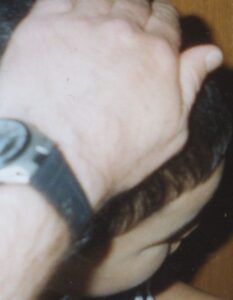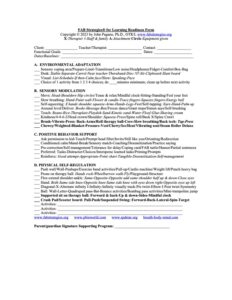
Initial research supports the efficacy of improving interoceptive body awareness difficulties in a school setting to promote self-regulation and school participation (Mahler et al., 2022). Interoceptive body awareness provides foundational embodiment forming our felt sense of self. Interoceptive awareness carries information about our internal state through unmyelinated fibers that convey internal body signals (cuddling relational touch, thirst, heart rate, itch, pain). Difficulties with interoceptive awareness and sensory processing are significantly more common in students with Autism Spectrum (DuBois et al., 2016), Post Traumatic Stress, and Mental Health Disorders (Khalsa et al., 2018).
Improving interoceptive awareness in PTSD, mental health, and Autism Spectrum disorders appears to promote self-regulation by increasing students’ understanding of the relationship between their internal sensations, feelings, and functional participation in meaningful activities (Price & Wang, 2021; Mahler et al., 2022). Interoception appears to overlap with and uniquely expand sensory processing interventions to affect occupational performance (Brown & Dunn, 2023).
Positive interoceptive body awareness can be improved through mindfulness, touch, and sensory approaches (Khalsa et al., 2018). See BLOG on INTEGRATING INTEROCEPTIVE & SENSORY STRATEGIES Using pictures to enable youth to recognize their body triggers, environmental triggers, and most effectively engage in early implementation of effective coping strategies can improve behavior (Weng et al., 2021; Price & Weng, 2021). The FAB Trigger & Coping Forms can be used during OT assessment and intervention to involve students in identifying (3 from each page) their major triggers and most effective coping strategies FABTriggerCopingForms
Several FAB Strategies provide interoceptive body awareness through mindfulness, slow deep breathing, awareness of movement, imagining positive feelings toward others, and self-touch. Specific FAB Strategies integrating movement are the Hand, Paint wall, Flower & candle, Squeeze fingers, Energy ball, and 4-4-4-6-2 breathing. Movement and body awareness activities are in the Mindful clock strategy (involving touch of body parts and forward-back, up & down, and lateral movements). Empathy can be enhanced through the Kindness strategy (a simplified, shortened version of the Loving Kindness meditation). Self-touch body awareness FAB Strategies are the: Self squeezing: Shoulders, Arms, Hands, Fingers, Legs, and Feet as well as Self-tapping and trace fingers strategy (directing students to slowly, gently “trace” up the sides of their fingers breathing in and down breathing out).

Specific FAB Strategies were also specifically developed to provide interoceptive awareness through light slow touch to specific body surfaces. The affective touch strategies include the Head Crown (light contouring touch on the top of the head); Back X (drawing an “X” across a child’s back moving the therapist’s fist slowly and lightly); and spine crawl (alternately moving slowly and gently up the sides of the spine with the therapist’s knuckles). These three FAB Strategies interventions provide the light, slow touch inputs on the head and back found in initial research to stimulate C-tactile fibers connected to the insular cortex promoting attention, body awareness, positive affect, and social skills (Pinna & Edwards, 2020; Pawling et al., 2017; Walker et al., 2022; Edwards et al., 2018).

The interoceptive awareness strategies described above are all included on the FAB Strategies for Learning Readiness form

Using FAB Strategies involving mindfulness, slow deep breathing, awareness of movement, imagining positive feelings toward others, self-touch, and specific light touch to promote interoceptive body awareness can provide a vital foundation for positive school behavior and learning.
References
Brown, C., & Dunn, W. (2023). Development of a Participation Focused Measure of Interoception for Adults. OTJR: Occupational Therapy Journal of Research, 43(2), 264-270.
DuBois D, Ameis SH, Lai MC, Casanova MF, Desarkar P. Interoception in autism spectrum disorder: A review. International Journal of Developmental Neuroscience. 2016 Aug 1;52:104-11.
Edwards, D. J., Young, H., Curtis, A., & Johnston, R. (2018). The immediate effect of therapeutic touch and deep touch pressure on range of motion, interoceptive accuracy and heart rate variability: a randomized controlled trial with moderation analysis. Frontiers in integrative neuroscience, 12, 41.
Khalsa SS, Adolphs R, Cameron OG, Critchley HD, Davenport PW, Feinstein JS, Feusner JD, Garfinkel SN, Lane RD, Mehling WE, Meuret AE. Interoception and mental health: a roadmap. Biological Psychiatry: Cognitive Neuroscience and Neuroimaging. 2018 Jun 1;3(6):501-13.
Mahler, K., Hample, K., Jones, C., Sensnig, J., Thomasco, P., & Hilton, C. (2022). Impact of an interoception-based program on emotion regulation in autistic children. Occupational therapy international, 2022.
Pawling, R., Cannon, P. R., McGlone, F. P., & Walker, S. C. (2017). C-tactile afferent stimulating touch carries a positive affective value. PloS one, 12(3), e0173457.
Pinna, T., & Edwards, D. J. (2020). A systematic review of associations between interoception, vagal tone, and emotional regulation: Potential applications for mental health, wellbeing, psychological flexibility, and chronic conditions. Frontiers in psychology, 11, 1792.
Price, C. J., & Weng, H. Y. (2021). Facilitating adaptive emotion processing and somatic reappraisal via sustained mindful interoceptive attention. Frontiers in Psychology, 12, 578827
Walker, S. C., Marshall, A., & Pawling, R. (2022). Psychophysiology and motivated emotion: testing the affective touch hypothesis of C-tactile afferent function. Current Opinion in Behavioral Sciences, 43, 131-137.FABPreKKForm
